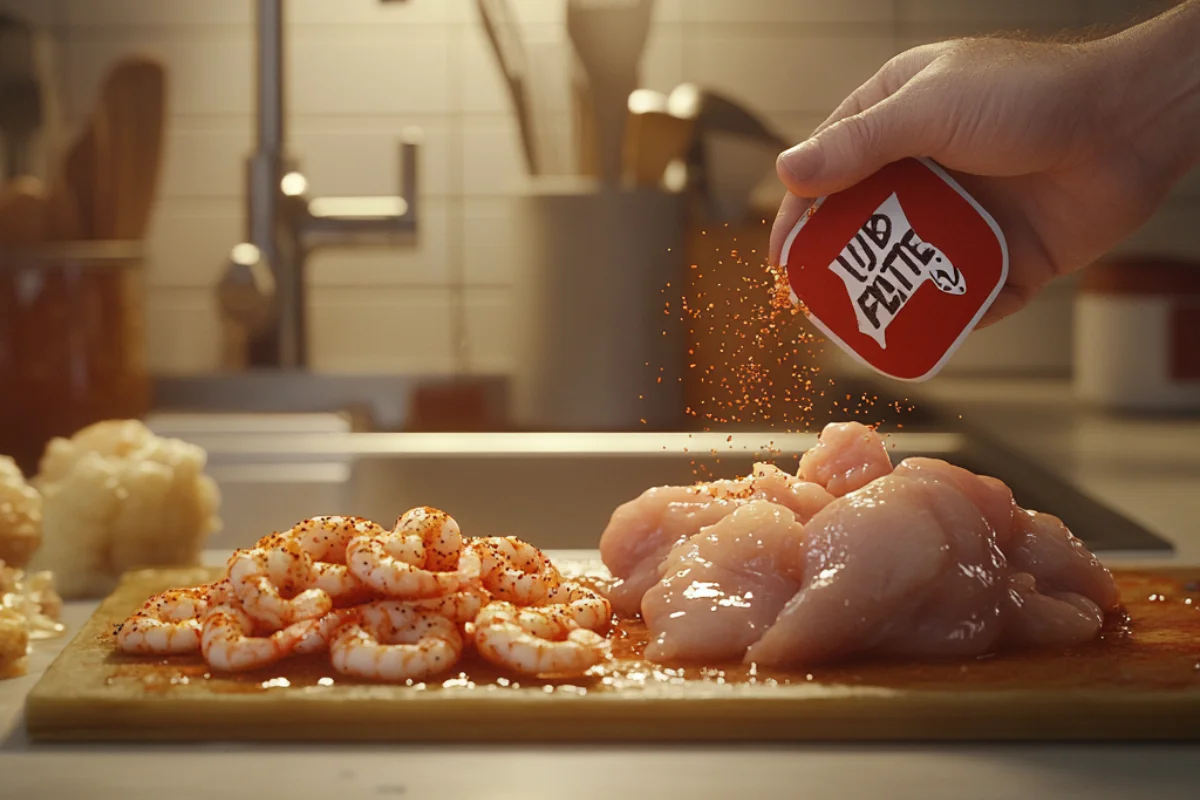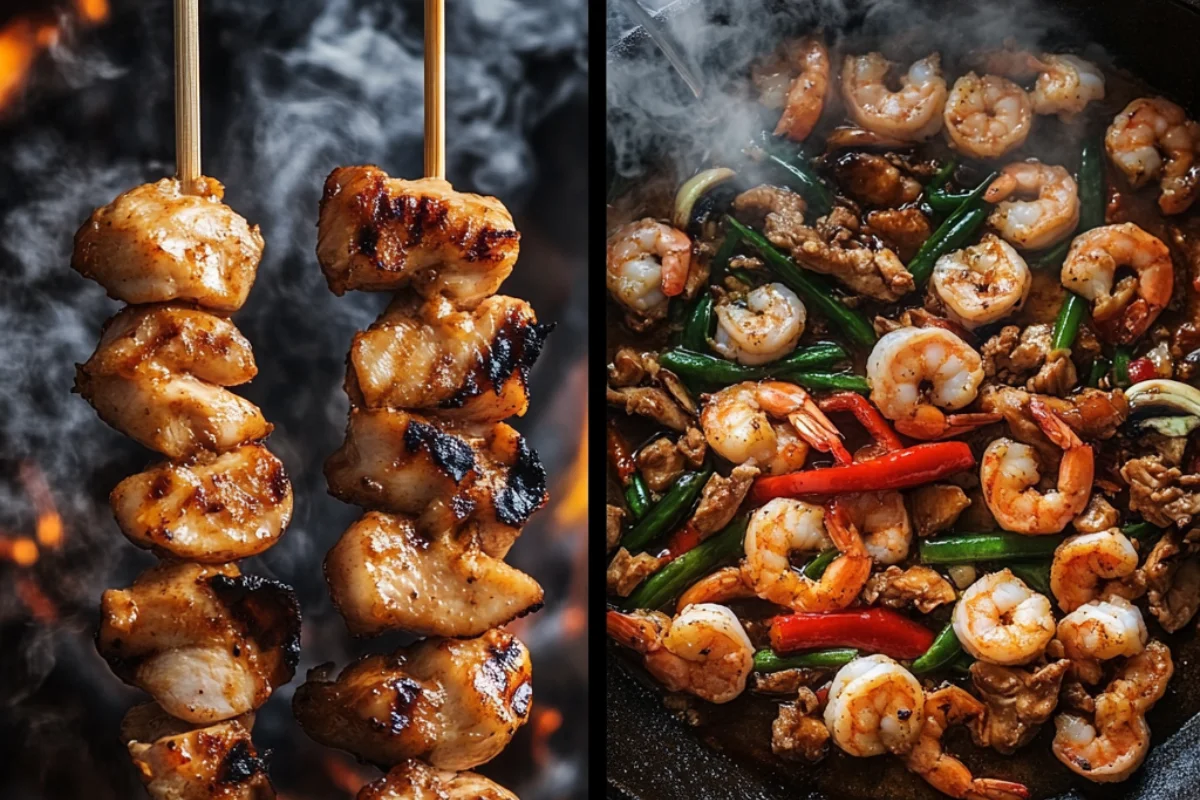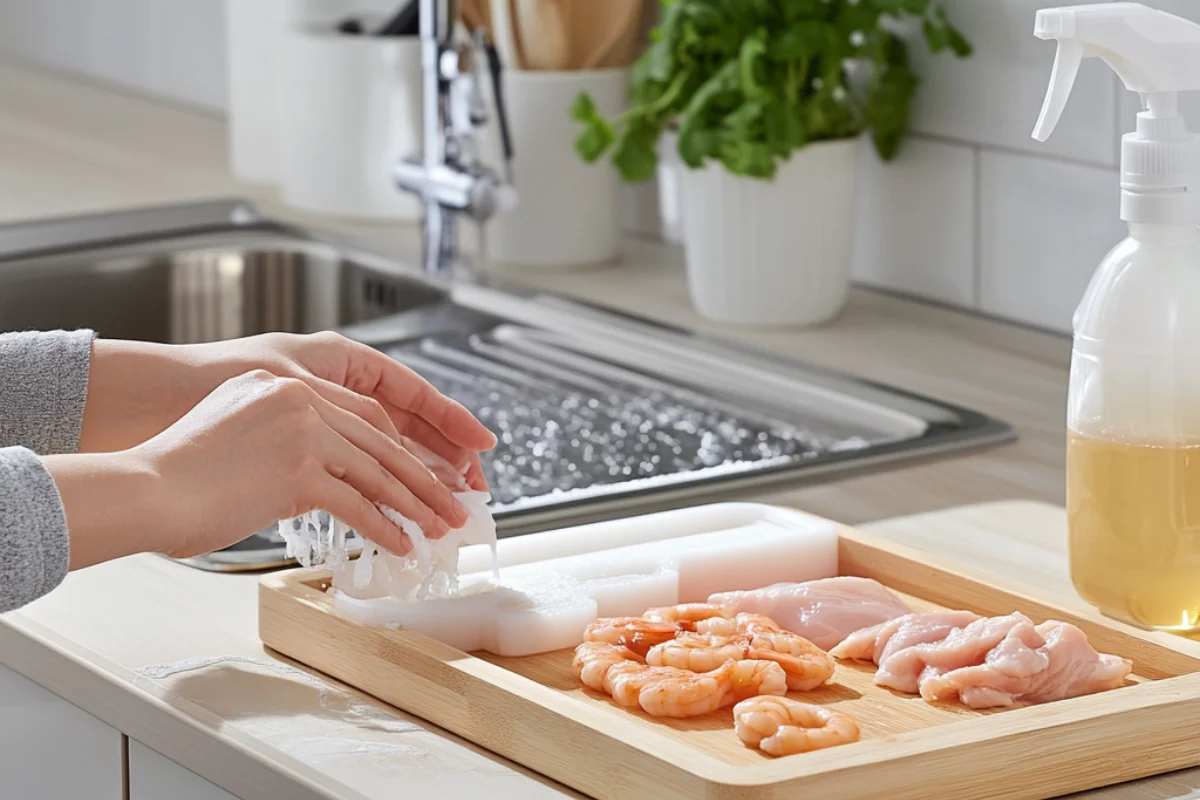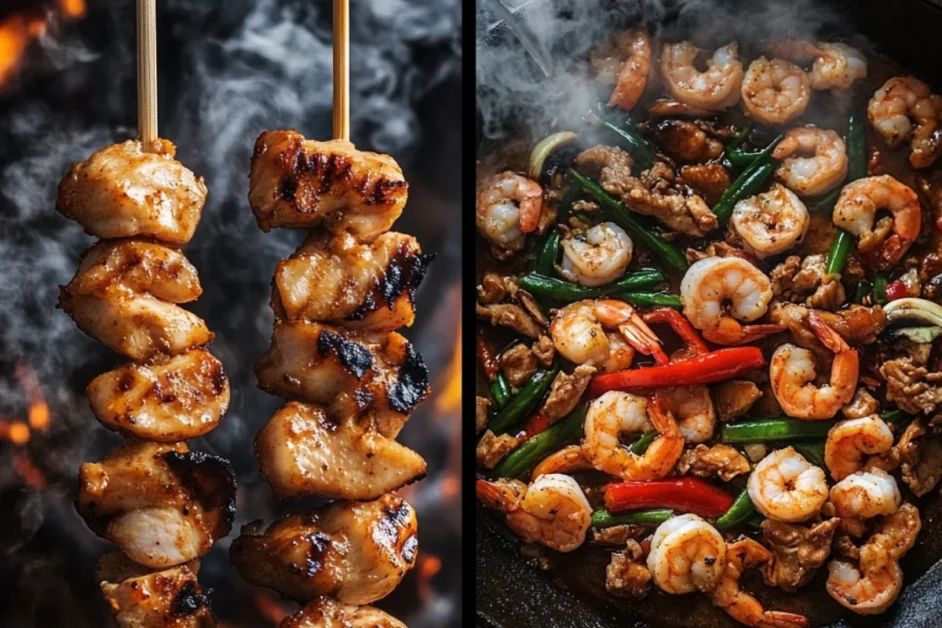When preparing a meal that includes both chicken and shrimp, you may wonder: Can you season them together? While it might seem convenient to coat them with the same seasoning blend, there are some food safety and cooking technique concerns to consider.
Understanding Cross-Contamination Risks

The biggest concern when handling raw chicken and raw shrimp together is cross-contamination. This occurs when harmful bacteria from one food transfer to another, potentially leading to foodborne illnesses.
Bacterial Concerns with Raw Poultry vs. Seafood
- Raw Chicken: Contains Salmonella, Campylobacter, and Clostridium perfringens. These bacteria can cause severe food poisoning if ingested.
- Raw Shrimp: May carry Vibrio bacteria and Listeria, which can also lead to foodborne illness if not handled properly.
Even though both proteins need to be cooked, shrimp requires far less heat and cooks much faster than chicken. If seasoned together, raw chicken bacteria can transfer to the shrimp. Since shrimp cooks quickly, it might not reach a high enough temperature to kill off any chicken-related bacteria.
Safe Food Handling Guidelines
To avoid cross-contamination:
- Use separate utensils and bowls when handling raw chicken and shrimp.
- If seasoning them together, ensure everything is fully cooked to 165°F, which is the safe internal temperature for chicken.
- Wash hands thoroughly after touching raw meat and seafood.
- Clean all surfaces with antibacterial soap or a bleach solution after preparing raw proteins.
- If marinating both together, do not use the same marinade unless it is fully cooked before serving.
Differences in Cooking Times and Techniques
Beyond food safety concerns, chicken and shrimp have different cooking requirements, making it difficult to cook them together in the same dish without overcooking one or undercooking the other.
How Chicken and Shrimp Cook Differently
- Chicken is a dense protein that requires longer cooking times at higher temperatures. It typically needs grilling, baking, or slow cooking to ensure the inside is cooked through.
- Shrimp, being a delicate seafood, cooks in just 2-3 minutes per side. Overcooking shrimp makes it rubbery and tough.
Why Cooking Temperatures Matter
- Chicken must reach an internal temperature of 165°F (75°C) to kill bacteria.
- Shrimp, on the other hand, is fully cooked at 120-140°F (49-60°C).
Because of this gap, cooking them together is tricky. By the time the chicken is safe to eat, the shrimp will likely be overcooked and chewy.
Best Practices for Cooking Chicken and Shrimp Together
If you still want to cook them in the same dish:
- Cook the chicken first until it reaches at least 155-160°F.
- Add shrimp at the very end and cook just until they turn pink and opaque (usually 2-3 minutes).
- Use separate pans or cooking methods (e.g., grill chicken separately while sautéing shrimp).
- Skewer them separately if grilling to control cooking times more easily.
- Marinate them separately to avoid bacterial transfer.
By following these guidelines, you can still enjoy the flavors of both proteins while keeping food safety and texture in mind.
Proper Seasoning Techniques for Chicken and Shrimp
When cooking with both chicken and shrimp, seasoning them correctly is key to balancing flavor, texture, and food safety. While it may seem convenient to season them together, it’s important to follow best practices to avoid cross-contamination and to bring out the best in each protein.
Best Practices for Seasoning Chicken and Shrimp
Since chicken and shrimp have different textures, flavors, and cooking times, their seasoning techniques should be adjusted accordingly.
Should You Use Separate Bowls for Seasoning?
Yes! Using separate bowls for seasoning is the safest way to:
- Prevent cross-contamination (raw chicken can carry bacteria that shrimp may not reach a high enough temperature to kill).
- Ensure even seasoning (shrimp requires less seasoning compared to chicken).
- Maintain the right texture (shrimp absorbs marinades faster, so it can become mushy if left too long).
Best approach:
- Mix seasonings in one container and portion them out into separate bowls for chicken and shrimp.
- If marinating, keep each protein in its own sealed bag or covered dish in the fridge.
Combining Seasonings Without Mixing Raw Proteins
If you want both chicken and shrimp to have the same flavor profile, you can:
- Make a large batch of seasoning mix (dry rub or wet marinade).
- Divide it into two portions—one for the chicken and one for the shrimp.
- Season the proteins separately in different bowls.
- Cook them according to their ideal temperatures and methods.
This ensures the flavors stay consistent without compromising food safety or texture.
Marinades and Seasoning Blends
Marinades can add depth and richness to both chicken and shrimp, but they must be used carefully.
Should You Marinate Chicken and Shrimp Together?
No, it’s not recommended because:
- Chicken takes much longer to marinate (anywhere from 30 minutes to 24 hours) to fully absorb flavors.
- Shrimp, being delicate, only needs 15-30 minutes in a marinade.
- Acidic marinades can start cooking shrimp prematurely, making it mushy.
- If raw chicken and shrimp are marinated together, the bacteria from the chicken can contaminate the shrimp.
Better approach:
- Prepare a single marinade and divide it into two portions.
- Marinate chicken separately for longer.
- Add shrimp to the marinade just before cooking to prevent over-marination.
How Acidic Marinades Affect Each Protein
Acidic ingredients like lemon juice, vinegar, and citrus are great for adding brightness to seafood and poultry, but they affect them differently:
- Chicken: Benefits from acidic marinades as they help tenderize the meat over time.
- Shrimp: Too much acidity can start breaking down the shrimp’s structure, making it soft and unpleasantly mushy.
Best strategy:
- If using acidic ingredients, limit shrimp’s exposure to 15-30 minutes.
- For chicken, longer marination (2-4 hours or overnight) allows for deep flavor penetration.
Flavor Pairing Tips for Chicken and Shrimp
To make a delicious and harmonious dish, it’s important to use seasonings that complement both proteins.
Herbs and Spices That Work for Both
Since shrimp has a mild, sweet taste and chicken is neutral, you can use spices that enhance both without overpowering either.
Great choices:
- Garlic & Onion Powder – Adds depth without overwhelming delicate shrimp.
- Paprika – Provides a smoky or mild heat that works with both proteins.
- Cumin & Coriander – Brings warm, earthy notes that enhance grilled or roasted dishes.
- Chili Flakes or Cayenne – A touch of heat pairs well with shrimp’s sweetness and chicken’s savoriness.
- Citrus Zest (Lemon/Lime) – Brightens both proteins, especially for seafood-inspired dishes.
- Fresh Herbs (Cilantro, Basil, Thyme, Oregano, Parsley) – Add freshness and balance.
Common Mistakes to Avoid
Over-marinating shrimp – Avoid leaving shrimp in marinade for too long, or it will turn mushy.
Mixing raw chicken and shrimp – Always season or marinate them separately to prevent contamination.
Using only dry rubs on shrimp – Shrimp benefits from a light marinade to help it retain moisture.
Forgetting cooking times – Shrimp cooks much faster than chicken; add it later to prevent overcooking.
Ignoring seasoning balance – Chicken can handle stronger spices, while shrimp needs a more delicate touch.
Final Thoughts
While chicken and shrimp can be seasoned similarly, they should always be handled separately to avoid food safety issues. Using the same flavors while marinating and seasoning individually will help you achieve a perfectly balanced dish without compromising taste or texture.
Safe Cooking Methods for Chicken and Shrimp
Cooking chicken and shrimp together requires careful attention to food safety, cooking times, and proper techniques. Since these proteins have different cooking temperatures and textures, following the right methods ensures both are flavorful, safe, and not overcooked.
Cooking Chicken and Shrimp Together Safely
To cook chicken and shrimp in the same dish, you need methods that allow staggered cooking times, ensuring both proteins reach their ideal doneness.
Best Cooking Methods (Grilling, Stir-Frying, Baking)

Grilling:
- Best for bold, smoky flavors with marinades or spice rubs.
- Cook chicken first (since it takes longer), then add shrimp for the last 2-3 minutes of grilling.
- Use separate skewers for better control.
Stir-Frying:
- Ideal for quick, high-heat cooking.
- Start by cooking chicken until almost done, then add shrimp at the end.
- Keep the shrimp moving in the pan to avoid overcooking.
Baking:
- Best when making one-pan meals.
- Bake chicken first at 375-400°F until almost fully cooked, then add shrimp in the last 5-7 minutes.
- Use a sheet pan for easy cleanup.
Should You Cook Chicken First, Then Add Shrimp?
Yes! Since chicken needs longer cooking and must reach 165°F, it should always be cooked first before shrimp is added.
Here’s the best approach:
- Start with chicken – Cook it until almost done (about 75-80% cooked).
- Introduce shrimp – Add shrimp for the last few minutes to avoid overcooking.
- Check internal temperatures – Chicken must be at 165°F; shrimp is ready at 120-140°F.
This ensures both proteins are safe to eat and taste delicious.
Proper Storage and Handling
Proper storage prevents bacterial growth and keeps your ingredients fresh and safe for cooking.
How to Store Raw Chicken and Shrimp Safely
In the fridge:
- Store raw chicken on the bottom shelf in an airtight container to prevent drips.
- Keep raw shrimp in a sealed bag or container on a higher shelf.
- Store at 40°F (4°C) or below to prevent bacterial growth.
In the freezer:
- Freeze chicken for up to 9 months if stored properly.
- Freeze shrimp for up to 3-6 months.
- Thaw in the refrigerator overnight, never at room temperature.
How Long Can You Keep Seasoned Chicken and Shrimp in the Fridge?
- Raw seasoned chicken: Up to 24 hours before cooking.
- Raw seasoned shrimp: No more than 12 hours (acidic marinades can break it down too fast).
- Cooked chicken and shrimp: Up to 4 days if stored properly in an airtight container.
Tip: If you don’t plan to cook within 24 hours, freeze the seasoned chicken or shrimp to maintain freshness.
Final Tips for Food Safety and Flavor
How to Avoid Cross-Contamination in Your Kitchen

Use separate utensils – Have different cutting boards and knives for raw chicken and raw shrimp.
Wash hands thoroughly – Scrub hands with soap and warm water after handling raw meat.
Sanitize all surfaces – Clean countertops and tools with disinfectant or hot soapy water.
Never reuse marinade – If marinating, discard any liquid that came in contact with raw proteins.
Summary of Best Practices for Cooking and Seasoning
Season separately – Use the same spice mix, but keep proteins in separate bowls.
Cook chicken first – Since it takes longer, always start with chicken and add shrimp later.
Use safe temperatures – Chicken at 165°F, shrimp at 120-140°F.
Avoid over-marinating shrimp – No more than 30 minutes to prevent mushy texture.
Store properly – Keep raw chicken and shrimp separate in the fridge and use within safe time limits.
By following these safe cooking techniques, you can enjoy delicious chicken and shrimp dishes without compromising food safety or texture.
FAQs: Cooking Chicken and Shrimp Together
Here are 5 common questions people have about cooking chicken and shrimp together, along with detailed answers to ensure safe and delicious results.
1. Can I season raw chicken and shrimp together?
No, it’s not recommended. Raw chicken can carry bacteria like Salmonella, which may transfer to shrimp. Instead, season them separately or use the same spice mix in different bowls.
2. Is it safe to marinate chicken and shrimp in the same container?
No. Chicken requires longer marination (30 minutes to 24 hours), while shrimp should only be marinated for 15-30 minutes. If marinated together, the shrimp could become mushy and contaminated with chicken bacteria.
Solution: Prepare one marinade, divide it into two portions, and marinate each protein separately.
3. What is the best way to cook chicken and shrimp together?
The best cooking methods are:
- Grilling – Cook chicken first, then add shrimp for the last 2-3 minutes.
- Stir-frying – Sauté chicken first, then toss in shrimp at the end for a quick cook.
- Baking – Roast chicken first and add shrimp in the last 5-7 minutes.
Always stagger cooking times so the shrimp doesn’t overcook.
4. How do I prevent shrimp from overcooking when cooking with chicken?
Cook chicken first until it’s nearly done (about 80% cooked).
Add shrimp at the very end and cook for only 2-3 minutes per side until opaque.
Shrimp should reach 120-140°F, while chicken must be at 165°F.
5. Can I store raw chicken and shrimp together in the fridge?
No! Always store them separately in airtight containers to avoid bacterial transfer.
- Chicken: Store on the bottom shelf to prevent drips.
- Shrimp: Store on a higher shelf in a sealed container.
Both should be stored at 40°F (4°C) or below and used within 1-2 days.

